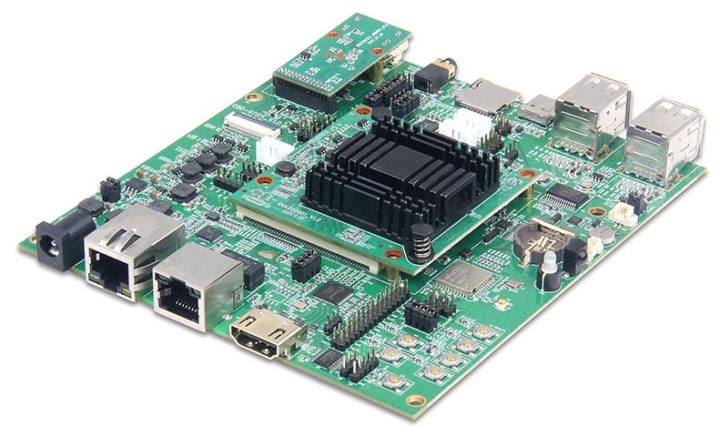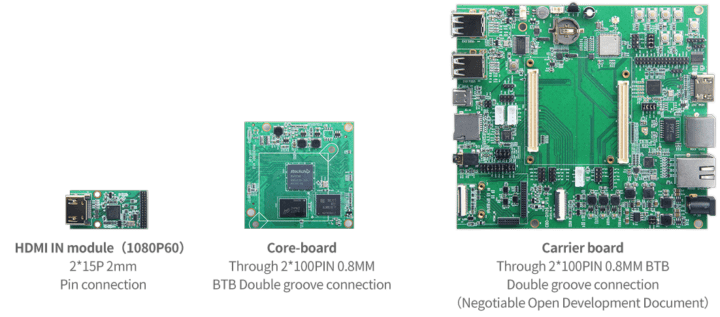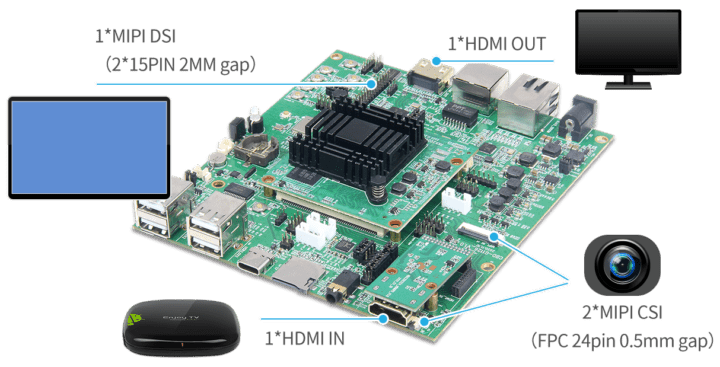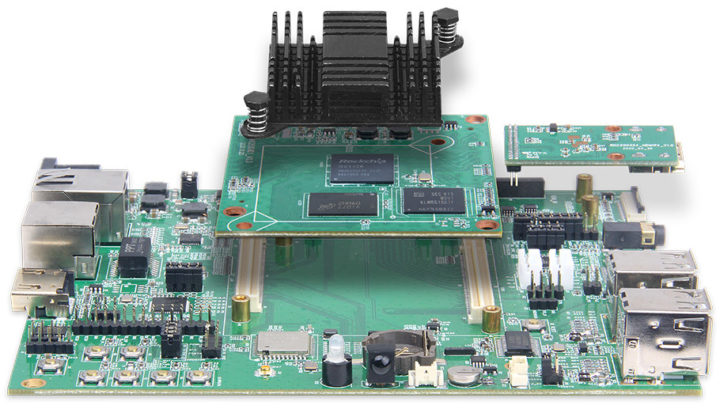Since the release of Rockchip RV1126 SoC, we have covered the detailed specifications on the chip and the RV1126-based Firefly dual-lens AI camera module. To take advantage of hybrid MCU cores from ARM and RISC-V, Geniatech has announced the DB1126 development board, a new addition to their long list of ARM Embedded developer boards designed to tackle any task requiring artificial intelligence.

The new Developer Board 1126 development board gets its name from Rockchip RV1126 SoC with a quad-core ARM Cortex-A7 and RISC-V MCU and a neural network acceleration with performance up to 2.0 TOPS that support INT8/ INT16. As the company says, “DB1126 is a high-performance, versatile, high-computing (2TOPS) general-purpose, intelligent integrated carrier board + core board.” The board is not just a simple development board but also a carrier board with a core board connected via a board-to-board (BTB) double groove connection.
Geniatech has provided the DB1126 development board with 256MB RAM, which may be limited, but has an optional upgrade to up to 64GB (which is totally impossible as RV1126 is a 32-bit processor, and the maximum from the specs is 4GB). The board comes with 8GB of flash by default, which you can expand to 16GB if needed. For those looking to work on big projects that require inbuilt Wi-Fi, this board will take care of that aspect through the support of 802.11 a/b/g/n/ac versions.

High Performance for AI Workloads
The DB1126 development board gets the onboard core module alongside the built-in NPU and image signal processor becoming the best combination for any smart AI camera to get high performance. It should not be surprising that the board will primarily focus on applications related to Smart Home, video conference, video capture cards, and 4K wireless projectors.

With a complete hardware-based 14-megapixel ISP and post-processor, the DB1126 development board can run several algorithms for all-time real-time processing features that make it suitable for intelligent AI cameras.
Apart from the NPU and ISP, the RV1126 SoC comes with a 4K H.264/H.265 encoder and decoder required to live stream any video file through inbuilt Wi-Fi support. The board also gets a MIPI-DSI interface for connecting the host processor and a display module capable of displaying full HD video at 1080P 60fps.
What’s next with the DB1126 Development Board?
Along with Wi-Fi connectivity, you also get the option to use Bluetooth 4.2/5.0 version for short-range wireless transmission. As with all developers, the best operating system for easy deployment of programs is Embedded Linux that can be taken on this SBC.
Other than the MIPI-DSI interface, there are two MIPI-CSI interfaces for you to connect camera modules. There is also an HDMI output for any display or monitor that can be connected to the single-board computer. The HDMI input module allows you to capture HDMI audio/video input. This has become one of the important features of this board as most of you might have come across that Raspberry Pi 4 does not directly take HDMI signals (you need a capture card for that).

As of now, there is no information on how to get started, but the board will support Linux, and we are expecting the documentation to be released soon. The company also adds that they will provide SDK secondary development for all the customers to meet their requirements. With the customization feature of optional hardware setup that involves CPU, memory, storage, etc., it is perfect for the hobbyist to want to explore the board’s capabilities.
If you are interested in getting your hands on the board, you will have to wait as it is not listed on the Geniatech store. Even though the pricing has not yet been made public, you can contact the company via the product page for a volume quote.

Abhishek Jadhav is an engineering student, RISC-V Ambassador, freelance tech writer, and leader of the Open Hardware Developer Community.
Support CNX Software! Donate via cryptocurrencies, become a Patron on Patreon, or purchase goods on Amazon or Aliexpress





